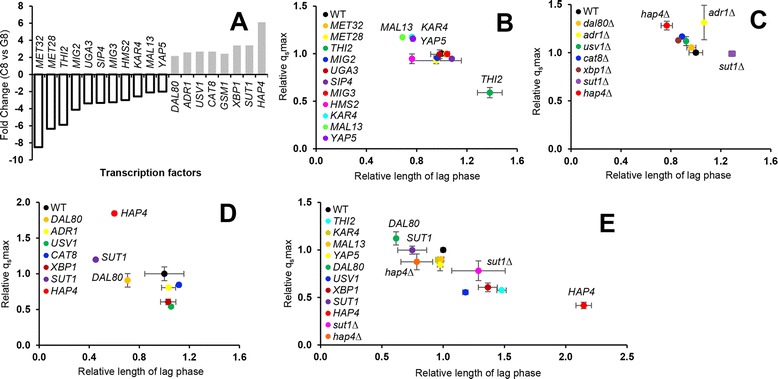Figure 3.

The effect of manipulating transcription factors (TFs) on cellobiose fermentation. (A) TFs with significantly different expression levels on cellobiose versus glucose. For all TFs shown, P-values were well below 0.001 (see Additional file 2: Dataset S2). (B) Cellobiose fermentation profiles of TFs overexpressed in strain BY4742. The TFs chosen for overexpression were those downregulated in cellobiose in the wild-type (WT) strain. The relative cellobiose-consumption rate (qsmax) and the relative length of the lag phase [100,101] were obtained by comparisons WT controls (normalized to 1.0). (C) Cellobiose fermentation profiles of deletion strains in BY4742 background for TFs upregulated in cellobiose versus glucose in (A). (D) Cellobiose fermentation profiles of strains overexpressing TFs upregulated on cellobiose versus glucose in (A). (E) Cellobiose fermentation profiles using TF mutants in strain D452-2. Because D452-2, which is another laboratory strain of S. cerevisiae, seems to have comparable fermentation performance to industrial strains, this strain has attracted attention as a host strain to express foreign sugar-utilizing pathways. In all of the above panels, the cellobiose-consumption pathway was expressed from plasmid pRS316-BT. For panels (B-E), plots of relative qsmax versus relative length of the lag time are shown. Each point represents duplicate anaerobic fermentations using a starting cellobiose concentration of 80 g/l and starting OD600 of 1. The maximum cellobiose-consumption rate and length of the lag phase were 1.22 ± 0.09 g/l/h and 74.28 ± 3.70 h, respectively, for the WT BY4742 strain, and 1.18 ± 0.00 g/l/h and 58.32 ± 2.77 h for the WT D452-2 strain.
